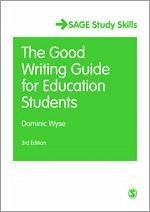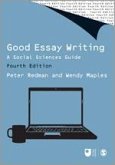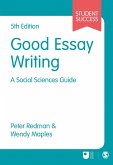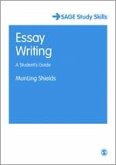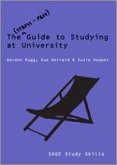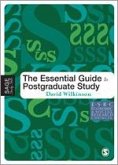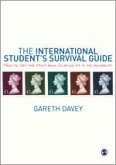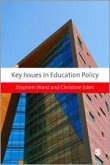This accessible guide to writing academically is based on the author's many years of experience helping students to improve their writing and get better marks in assignments. The advice works because it uses real examples of students' work to explain what tutors look for, and shows you how to get there. New to this Third Edition: - increased coverage of plagiarism (and how to avoid it) - how to show critical reflection and judgement - turning useful notes from lectures and readings into powerful written arguments - updated material on citations and references - new examples of students' work - developing an academic 'voice'. The book is packed with practical advice on how to read widely, search for reading materials, structure your writing and use language effectively. With plenty of dos and don'ts, this is a perfect guide for students studying at all levels. Dominic Wyse is Professor of Early Years and Primary Education at the Institute of Education, University of London. SAGE Study Skills are essential study guides for students of all levels. From how to write great essays and succeeding at university, to writing your undergraduate dissertation and doing postgraduate research, SAGE Study Skills help you get the best from your time at university. Visit the for tips, quizzes and videos on study success!
'I am delighted to see this new edition. As well as the wealth of knowledge provided in earlier versions, new and welcome additions address emerging priorities for university education courses and invite the reader's active participation. It will be at the top of my department's reading lists!' - Dr Shereen Benjamin, Senior Lecturer in Primary Education The University of Edinburgh ------------------------------------------------------------------------ 'A highly appropriate text for all education students, the inclusion/analysis of tutors' comments alongside the existing Top Tips enhances the advice given. The close analysis of student work, identification of both effective and ineffective features and the detailed information regarding effective searches are amongst the many highlights' - Mike Hickman, Head of Subject, Initial Teacher Education York St John University
STUDENT REVIEW:
This is a comprehensive and engaging book for self-study. It has introduced me to the basis of good academic writing, in particular because it uses simple language to explain the many steps taken while reading and writing critically. It goes from reading widely, planning, developing your own voice, critically organizing thoughts to writing a dissertation and proofreading. In other words, I would say that this book goes from A to Z. I feel as if my anxieties, doubts and insecurities with regard to writing have been clarified by a friend. I wish I had read this book before taking a Master s course.
Notes on Specific Chapters
The book is very well organized giving very clear steps to writing your own essay.
The top tips in boxes are important as they draw your attention to relevant points that might otherwise not be noticed if they were in middle of the text. In the same way, the Key Fact, which gives a brief explanation, helps foreign students in particular to understand the basic terminology used in the academic field.
The examples given to illustrate the explanation are very useful because they show in practice how to apply the explanation.
Another strong point of the book is its reference to the chapters, in order to gather more information about what has been explained. In this sense, this book covers all the points that enable students to become effective critical readers and writers. The interesting point is that when you start to read, some questions may be raised but they are then answered through your reading on, so it can be suggested that the book engages in a conversation with you.
It brings to our attention the number of times that an article is cited, which is an indication that the article is relevant academically.
The chapter on criticality, an area which most students find challenging, gives a clear explanation of how to apply critical thinking constructively. It differentiates between the subjective role of the reader and the reader s ability to offer objective criticism.
Although planning your essay beforehand is one of the most important steps, it can be quite tricky but in chapter 4 the book gives a clear idea of how to plan and from where to start.
Writing Chapter: The relevance of the introduction and its connection with the conclusion are given. What I find extremely useful is the guide to writing a strong conclusion, in that it explains that the information contained in it is a reiteration of the points mentioned in the introduction, but with critical engagement. Moreover, the example of subheadings, writing a topic sentence at the beginning of each paragraph in the main body of the essay, is a useful guide as this has clarified to me how to organise my arguments in a more coherent fashion.
The activity proposed in the reference chapter is useful as it checks our understanding and draws our attention to the most common mistakes made while citing.
Viviane Pereira Zanini 20170201
This is a comprehensive and engaging book for self-study. It has introduced me to the basis of good academic writing, in particular because it uses simple language to explain the many steps taken while reading and writing critically. It goes from reading widely, planning, developing your own voice, critically organizing thoughts to writing a dissertation and proofreading. In other words, I would say that this book goes from A to Z. I feel as if my anxieties, doubts and insecurities with regard to writing have been clarified by a friend. I wish I had read this book before taking a Master s course.
Notes on Specific Chapters
The book is very well organized giving very clear steps to writing your own essay.
The top tips in boxes are important as they draw your attention to relevant points that might otherwise not be noticed if they were in middle of the text. In the same way, the Key Fact, which gives a brief explanation, helps foreign students in particular to understand the basic terminology used in the academic field.
The examples given to illustrate the explanation are very useful because they show in practice how to apply the explanation.
Another strong point of the book is its reference to the chapters, in order to gather more information about what has been explained. In this sense, this book covers all the points that enable students to become effective critical readers and writers. The interesting point is that when you start to read, some questions may be raised but they are then answered through your reading on, so it can be suggested that the book engages in a conversation with you.
It brings to our attention the number of times that an article is cited, which is an indication that the article is relevant academically.
The chapter on criticality, an area which most students find challenging, gives a clear explanation of how to apply critical thinking constructively. It differentiates between the subjective role of the reader and the reader s ability to offer objective criticism.
Although planning your essay beforehand is one of the most important steps, it can be quite tricky but in chapter 4 the book gives a clear idea of how to plan and from where to start.
Writing Chapter: The relevance of the introduction and its connection with the conclusion are given. What I find extremely useful is the guide to writing a strong conclusion, in that it explains that the information contained in it is a reiteration of the points mentioned in the introduction, but with critical engagement. Moreover, the example of subheadings, writing a topic sentence at the beginning of each paragraph in the main body of the essay, is a useful guide as this has clarified to me how to organise my arguments in a more coherent fashion.
The activity proposed in the reference chapter is useful as it checks our understanding and draws our attention to the most common mistakes made while citing.
Viviane Pereira Zanini 20170201

